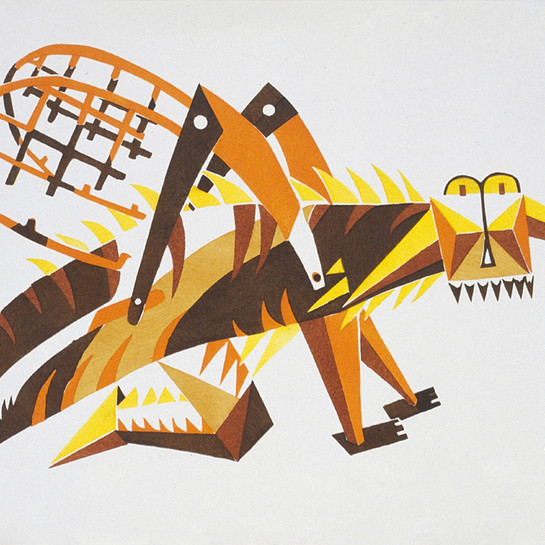Mikhail Fyodorovich Larionov
Russia, b.1881, d.1964
'Le Grillon', Musique de Ravel ('The Cricket', Music of Ravel)
- 1919
- Pochoir stencil print
- Presented by Anita Muling, 1979
- 323 x 500mm
- 80/9
Tags: costume (mode of fashion), insects
This print is from the folio L’Art Décoratif Théâtral Moderne (Modern Theatrical Decorative Art) produced in Paris in 1919 by leading European avant-garde artists Natal’ya Goncharova (1881–1962) and Mikhail Larionov (1881–1964). Including examples of the artists’ work in lithography and pochoir (stencil) printing, the folio highlights not only their interest in stage and costume design, but also their desire to combine the forms of cubism with the representation of movement. In 1912 Larionov initiated rayonism, an artistic genre in which he investigated the effect of light rays fracturing and reflecting off the surface of objects. The prints included in L’Art Décoratif Théâtral Moderne, with their rich decorative patterns, vibrant colours and abstract forms, highlight these concerns.
Goncharova and Larionov first met in 1898 as students at the Moscow School of Painting, Sculpture and Architecture and remained lifelong companions. Both artists were founding members of leading Russian avant-garde movements, including the Donkey’s Tail (1912), and worked with the renowned founder of Ballets Russes, Serge Diaghilev (1872–1929), from 1914. In 1919 they relocated to Paris, where they became prominent figures in the city’s artistic, dance and literary circles. Today they are widely regarded as the foremost Russian artists of the twentieth century.
L’Art Décoratif Théâtral Moderne was presented to the Gallery by Anita Muling in 1979.
Exhibition History
Art Detectives, 20 October 2006 - 25 March 2007
In Paris in 1919, the Russian artist Mikhail Larionov with his partner Natalia Goncharova published a folio of prints of their extraordinary costume designs for experimental theatre.
Larionov was inspired at this time by the excitement of the machine age, as well as by mechanical toys, Russian folk art and the art of children. These two designs were for a ballet that was never staged, 'mechanical costumes" that Larionov intended the dancer to wear while moving in a sharp, machine-like manner. Not very comfortable!
